 Brontosaurus.
Brontosaurus.
This is a starting collection of photo's of Origami folds of Dinosaurs and other prehistoric animals. I fold these models, using directions from different books, make a photo of them with the camera of my SGI workstation, and put them on the website. Apologies for poor quality of pictures, and in some cases, the folds have small errors (which are usually not visible due to the poor quality of the photo.) Folds are classified with respect to the book they are taken from.
See also:
Animal Origami for the Enthousiast. John Montroll. Dover Publications, 1985, ISBN 0-486-24792-9, 119 pages.
 Brontosaurus.
Brontosaurus.
One of my favourite models. I made many of them as decorations on two
of my children's birthday treats at school.
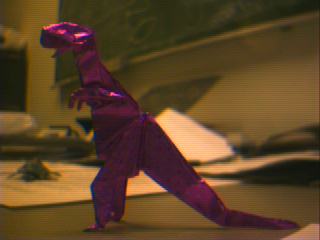 Tyrannosaurus.
Tyrannosaurus.
Prehistoric Origami - Dinosaurs and Other Creatures. John Montroll. Antroll Publishing Company, 1989, ISBN 1-877656-01-1, 143 pages. I believe a second edition was published by Dover.
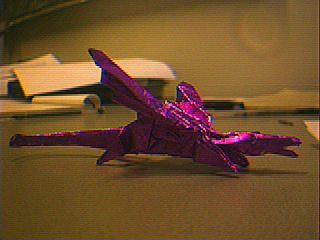 Kuehnosaurus.
Kuehnosaurus.
Given the final result, the model is less complicated than one would
expect. The sturdy foil I used makes that the wings easily have its nice
three-dimensional shape.
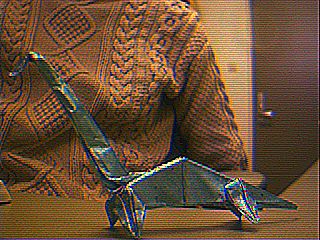 Elasmosaurus.
Elasmosaurus.
This animal lived in the water. I was informed that it is not actually a
dinosaur, but a reptile belonging to another group of animals, living at the
same time as the dinosaurs.
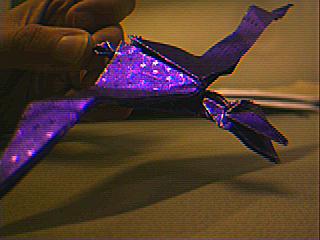 Pterodactylus.
Pterodactylus.
I used sturdy foil, with the same color at both sides. Perhaps paper
that is white at one side would be better, as the model should have white
eyes. This is one of the flying animals, living at the same time as the
dinosaurs.
 Quetzalcoatlys.
Quetzalcoatlys.
Another flying animal from dinosaur-time;
the same comment on the use of paper applies here
too.
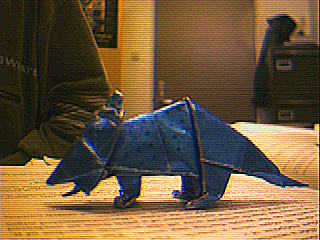 Protoceratops.
Protoceratops.
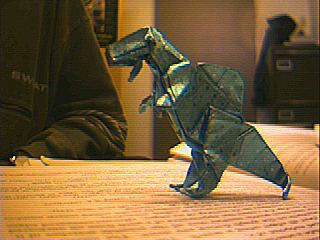 Spinosaurus.
Spinosaurus.
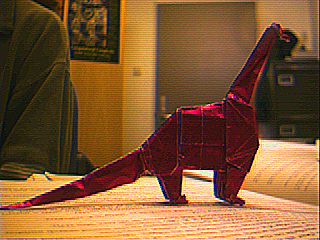 Brachiosaurus.
Brachiosaurus.
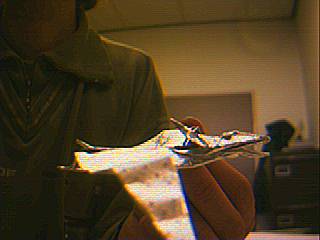 Pteranodon.
Pteranodon.
I found it hard to make a nice looking photograph of this model,
but it is actually quite nice.
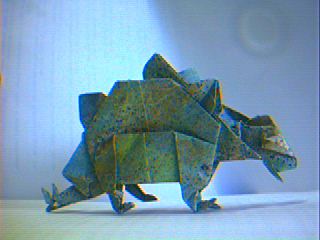 Stegosaurus.
Stegosaurus.
This is a wonderful model. A few steps are not easy but the final result is
wonderful, and when folded right still nicer than this photograph shows.
Making this stegosaurus costed me about one and a half hour, using a sheet of
24 by 24 centimetres, but there are little errors at details.
 Parasaurolophus.
Parasaurolophus.
The white horn on its head probably was a kind of musical instrument.
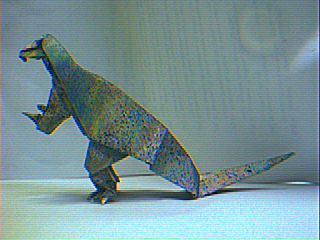 Iguanodon.
Iguanodon.
Unfortunately, the photo does not show some details very well. E.g.,
in this model, each foot has three toes.
 Triceratops.
Triceratops.
The triceratops or `three-horn' is a nice model. Unfortunately, the photo is
very poor, and the result, when folded well is much better than this photo
indicates. A triceratops I folded earlier was immediately recognized by my then
three-year old daughter as `Sera', a character from a dinosaurs movie.
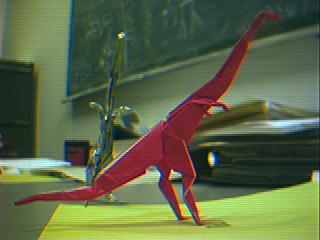 Struthiomimus.
Struthiomimus.
By gluing its feet to the ground, this model has its tail in the air. Usually, the model rests on tail and feet.
Dinosaurs must have been not too smart, as they had very small heads with
little brains.
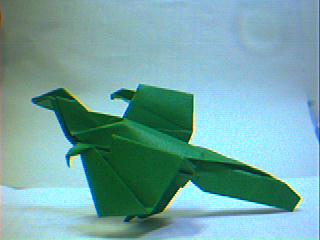 Archaeopterix.
Archaeopterix.
This winged prehistoric animal was still unable to fly.
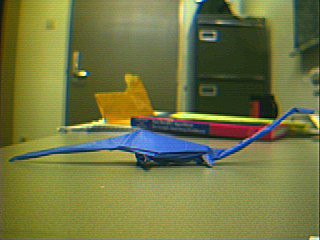 Tanystropheus.
Tanystropheus.
 HB's origami page hansb@cs.uu.nl.
HB's origami page hansb@cs.uu.nl.